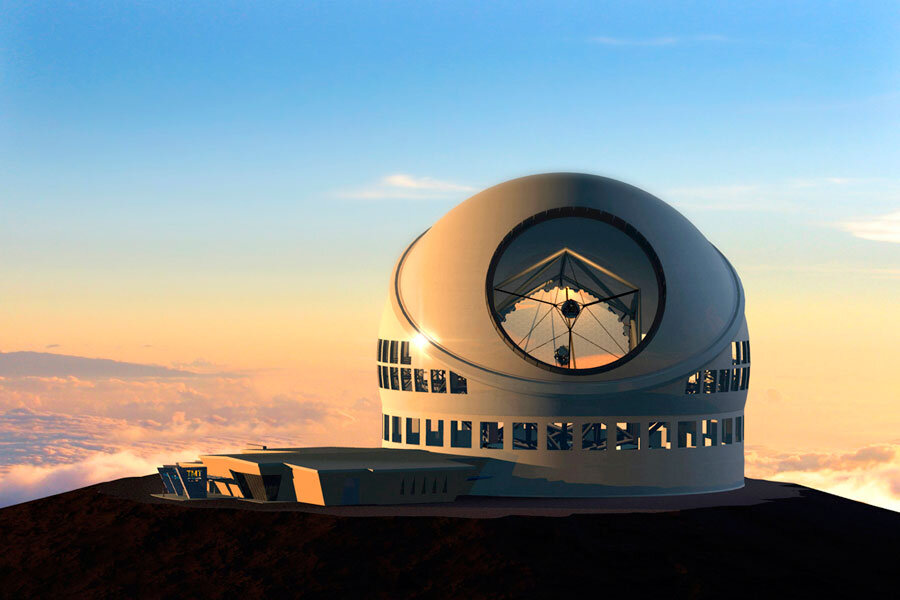Why are Hawaiians protesting a giant telescope?
Loading...
Eight people were arrested early Wednesday morning for protesting the construction of a giant telescope atop Mauna Kea, a mountain that native Hawaiians consider sacred.
The state Department of Land and Natural Resources (DLNR) said its officers arrested the protestors to enforce an emergency rule enacted by the land board to prevent protestors from camping on Mauna Kea during the night hours. The protesters were in a circle praying and chanting at the time of the arrest.
The emergency rule restricts access to the mountain between 10 p.m. and 4 a.m., ostensibly to ensure the safety of visitors at the other 13 telescopes already installed on the mountain.
“All of a sudden we saw the DLNR trucks coming and parking and they all came out and just took us,” Kuuipo Freitas, one of the eight arrested while in prayer, told Big Island News.
Another state agency asked the DLNR to cease enforcement and arrests. “It is our understanding that the individuals were arrested this morning while they were in the act of pule, or prayer,” said a statement from the Office of Hawaiian Affairs, a public agency charged with protecting the rights of native Hawaiians. “Native Hawaiians have constitutionally protected rights to reasonably engage in traditional and customary practices, and regulations cannot eliminate the exercise of these rights.”
Williamson Chang, a law school professor at the University of Hawaii has filed a lawsuit to repeal the DLNR’s emergency rule, arguing that it prevents telescope opponents from exercising their legal rights of protest, reports the Guardian.
Gov. David Ige (D) of Hawaii says there are no further legal barriers to constructing the telescope, as officials spent years securing the necessary paperwork and had over 20 public meetings with native Hawaiians regarding their concerns prior to construction.
Controversy has halted construction of the observatory, called the Thirty Meter Telescope (TMT), since April, and this is the fourth time that demonstrations against the telescope resulted in arrests. The original goal for completion was 2018, but the nonprofit company building the telescope is now unsure when construction will resume.
In Hawaiian mythology, the mountain peaks on the largest island of Hawai’i are sacred. Mauna Kea is the most sacred of them all because its peak, at 13,796 feet above sea level, is the highest point in the state. If measuring the mountain from its oceanic base, Mauna Kea would measure 33,000 ft, far taller than Mount Everest. This dormant volcano is referred to as the ‘piko’ or ‘umbilical cord’ connecting the islands to the heavens.
Astronomers also see Mauna Kea as a superb conduit between sky and Earth. “The atmospheric conditions, low average temperatures, and very low humidity will open an exciting new discovery space using adaptive optics and infrared observations,” said the TMT team when defending their selection of the Mauna Kea location.
Opposition to telescopes on Mauna Kea is not new, but the controversy surrounding the 18-story TMT has been unprecedented, according to Scientific American. A group of environmentalists are using the TMT construction as an avenue to voice a deeply-founded frustration over the desecration of sacred land that once belonged to the islands' sovereign, indigenous people.
But not all Hawaiians oppose the project. Some say they see the TMT as a source of technology education for the community and jobs for the local economy.
“As a ranger on Maunakea, I’ve enjoyed working with many astronomers, who are generally people of good will and from whom I have learned much about the stars,” says park ranger James Kealii Pihana. “But despite all of their scientific accomplishments, I do feel that much more needs to be done to bring awareness and respect for Hawaiian culture on the mountain. Science does play an important role in people’s lives, but it is not everything. A spiritual connection is just as important.”
Freitas says that all eight arrested individuals posted bail and returned to protest at Mauna Kea before 8 a.m.







